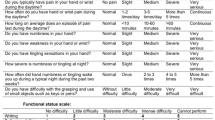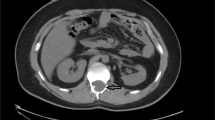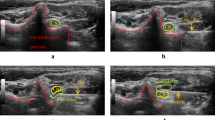Abstract
Study design
Retrospective case series.
Objectives
Dorsal root entry zone (DREZ) lesioning can be performed in patients with intractable pain following brachial plexus avulsion (BPA). However, post-operative outcomes are variable and it is uncommonly used. We sought to determine the pain outcomes and complication profile of DREZ lesioning for BPA.
Setting
Quaternary neurosurgical centre.
Methods
All patients that had undergone DREZ lesioning for BPA pain over a 13-year period were included. Patients were assessed for outcome with regard to degree of pain relief and presence of complications.
Results
Fourteen patients were reviewed, with a median post-operative follow-up duration of 27 months (1–145 months). Of these, ten were contactable for long-term telephone review, with a median post-operative duration of 37 months (11–145 months). At earliest review post-operatively, 12 of 14 patients (86%) had some level of pain relief: complete pain relief in four patients (29%) and partial pain relief in eight patients (57%). At most recent post-operative review, ten of 14 patients (71%) reported lasting significant pain relief: four (29%) had complete pain relief, six (43%) had partial pain relief and four (29%) had insignificant pain relief. Complications were predominantly sensory, including ataxia, hypoaesthesia and dysaesthesia. Four patients (29%) reported persistent motor complications at final follow-up.
Conclusions
DREZ lesioning is uncommonly performed. It remains a reasonable option for relief of refractory BPA pain in selected cases, though there is a significant complication rate. Future prospective studies may enable quantification of pre- and post-lesioning analgesic use, another important determinant of procedure success.
Similar content being viewed by others
Introduction
Brachial plexus avulsion (BPA) is a major injury, usually the result of high-velocity trauma occurring in a motorcycle accident setting. One of the disabling sequelae of BPA, apart from paralysis and anaesthesia of the affected limb, is severe neuropathic pain that can be unresponsive to conservative and surgical management options, including analgesics, brachial plexus re-implantation and spinal cord stimulation. Surgical lesioning of the dorsal root entry zone (DREZ), a neuroanatomical site considered important in spinal nociceptive processing, can be performed to relieve refractory pain in patients with BPA.
Originally developed in the 1970s [1, 2], DREZ lesioning has been used for a wide range of disorders featuring pain and spasticity. The predominant indication is to alleviate BPA pain, for which the success rate is in the region of 75% [3,4,5,6,7,8,9]. The main DREZ lesioning modalities in use are the combined microknife and bipolar coagulation procedure (known as ‘microsurgical DREZotomy’) and radiofrequency lesioning [3]. Whilst the ‘microsurgical DREZotomy’ technique continues to be widely used and has good long-term outcomes, radiofrequency lesioning has been used in the largest reported number of patients, and it is this modality which was used in the present study. In this study, we describe post-operative outcomes for patients that underwent DREZ lesioning for BPA pain.
Methods
Patient population
Between June 2006 and June 2019, a total of 16 patients with BPA were listed for DREZ lesioning at our centre under the senior author (D.C.). One patient had an intra-operative myocardial infarction before lesioning could begin, meaning that 15 patients received DREZ lesioning. One further patient had no documented follow up or contact details. The relevant clinical characteristics of all 16 patients are summarised in Table 1. The study was registered with and approved by the hospital Clinical Audit Service governance pathway (201920-16). No identifiable data was used and individual written patient consent was therefore waived.
Surgical technique
Via a midline posterior cervical skin incision and unilateral subperiosteal dissection, C5–T1 hemilaminectomies were performed. A paramedian cranio-caudal durotomy was made, exposing the hemi-cord and DREZ. Lissauer’s tract was identified by observing for pial disruption of avulsed rootlets and identifying any intact rootlets above or below the avulsed levels. A radiofrequency generator (Cosman, Boston Scientific), set at 70 °C and 15 s per lesion, was used to create serial lesions along the posterolateral sulcus, spaced 2 mm apart and ~2 mm deep.
Patient assessment
At review, patients were asked to retrospectively quantify pre-operative pain as well as post-operative (i.e. current) pain using visual analogue scale (VAS) scoring. Any persisting post-operative complications were documented. Relatives were interviewed in two cases where the patient was cognitively impaired, preventing VAS scoring of pain but permitting recording of complications. Documentation from outpatient clinic visits was used for four patients who were uncontactable. Median duration of post-operative telephone follow-up was 37 months (range 11–145 months).
Assessment of pain relief
The degree of pain relief after DREZ lesioning was qualitatively graded as ‘complete’ (2), ‘significant’ (1), ‘insignificant’ (0) or ‘worse’ (–1) at each post-operative time point available, including serial outpatient clinic visits and—in the ten cases for which this was possible—based on VAS score at final telephone follow-up. For the ten patients in whom VAS scores were obtained, this provided a standardised numerical comparison of pre- and post-operative pain.
Statistical analysis
The Wilcoxon signed-rank test (SPSS, IBM Corporation) was used to determine the statistical significance of post-operative change in VAS.
Results
Pain relief
Pain relief for the 14 patients in our series is summarised in Table 2, qualitatively graded over time as ‘worse’, ‘insignificant’, ‘significant’ and ‘complete’. At the latest follow-up point, four patients (29%) reported ‘complete’ pain relief, six (43%) reported ‘significant’ pain relief and four (29%) reported ‘insignificant’ pain relief.
In the ten patients providing VAS scores on telephone follow-up, the median retrospective VAS prior to DREZ lesioning was 9.1 (range 7–10), compared to a median VAS of 3.5 (range 0–9) at most recent review, representing a statistically significant reduction in BPA pain level (p < 0.005, Wilcoxon signed-rank test) (see Fig. 1). Duration of pre-operative BPA pain (calculated as age at DREZ lesioning minus age at BPA) was correlated with the degree of pain relief following DREZ lesioning (calculated as pre-operative VAS minus post-operative VAS) when an outlier of case 1 was excluded from the analysis (correlation coefficient = 0.41) (see Fig. 2).
Complications
There were no procedure-related mortalities amongst included patients. The most severe complication was an intra-operative non-fatal myocardial infarction at the time of initial muscle dissection, leading to abandonment of the lesioning stage of the procedure (case 16).
Other complications are represented in Fig. 3. Eight of the 14 patients (57%) that received DREZ lesions encountered significant motor and/or sensory complications persisting until most recent review. Sensory complications were overall more prevalent, most commonly affecting the lower limb ipsilateral to the DREZ lesion. Persistent sexual dysfunction as a result of DREZ lesioning was noted in one patient.
Discussion
Key findings
DREZ lesioning conferred a degree of pain relief in the majority (71%) of patients in this series: four patients (29%) had complete BPA pain relief at last follow-up, whilst six patients (43%) described partial pain relief. In four patients (29%), DREZ lesioning did not achieve any pain relief, or its benefit was negligible. In keeping with other studies [9,10,11], sensory complications (paraesthesia, dysaesthesia, hypoaesthesia and sensory ataxia) were more commonly encountered than motor deficits and sphincter/sexual dysfunction. Complications in DREZ lesioning can arise due to the close proximity of ascending and descending white matter tracts, with a degree of thermal propagation emanating from the radiofrequency lesioning probe. The frequently scarred and deformed gross appearance of the spinal cord following BPA necessitates careful identification of the target site [12].
The pain profiles in patients with BPA are highly variable, with differences in location, pain characteristic and pain severity [13]. Patients who experienced the greatest benefit from DREZ lesioning were generally those that had predominantly paroxysmal BPA pain rather than continuous or phantom components, though these too were relieved in some, as previously described [14]. Furthermore, with the exception of case 1 (whose DREZ lesioning was performed 46 years after the original injury, and whose BPA pain proved resistant to nerve transfers, amputation and deep brain stimulation), pre-operative duration of BPA pain was positively correlated with the degree of pain relief experienced after DREZ lesioning. Whilst previous studies reporting similar findings [7, 11, 15] have not provided pathophysiological explanations for this phenomenon, Du et al. recently hypothesised that increasing dorsal horn neuronal hyperactivity may arise over time with disinhibition of Lissauer’s tract []. This trend may also reflect more realistic expectations of surgical outcome in patients with a prolonged history of severe chronic pain, repeated visits to healthcare facilities resulting in better health literacy [16].
Selected cases of interest
A patient demonstrating the efficacy of DREZ lesioning for BPA pain is case 8, whose left-sided BPA at age 35 resulted in severe continuous pain shooting down to the left wrist, as well as paralysis of the left arm and hypoaesthesia distal to the forearm. The pain was refractory to proximal brachial plexus re-implantation and a variety of pharmacological agents (including pregabalin, nortriptyline, duloxetine, amitriptyline and repeated cervical injections). DREZ lesioning 6 years after BPA provided complete pain relief that was still persisting at 26 months post-operatively, with no analgesic requirement. No complications were associated with the procedure. The pain-freedom enabled the patient to have an ‘enjoyable’ life without impediment to activities of daily living.
By contrast, case 4 represented a poor outcome following DREZ lesioning. Right-sided BPA at age 21 resulted in constant ‘electrical’ pain that neither analgesic therapy with gabapentin, fentanyl, oxycodone and amitriptyline, nor brachial plexus re-implantation and subsequent above-elbow amputation was effective at relieving. The amputation resulted in additional painful sequelae of stump and phantom pain. The patient was listed for DREZ lesioning 12 years post-injury. After initial decrease in neuropathic pain severity to a ‘manageable’ level (documented at clinic review 4 months post-operatively), the pain returned to the same pre-operative level at final clinic follow-up 16 months post-operatively. Weakness of the contralateral elbow and transient ipsilateral shoulder pain were noted to have resulted from DREZ lesioning. The significant intra-operative finding in this case was extensive arachnoiditis and distortion of the spinal cord without clear demarcation of the DREZ, which made it difficult to accurately lesion Lissauer’s tract.
Case 7 was notable for demonstrating variable improvement in pain components. Left-sided BPA at the age of 27 gave rise to a continuous VAS 7 pain component interspersed around thrice daily with a paroxysmal ‘breakout’ VAS 10 element in spite of high-dose amitriptyline and pregabalin. Brachial plexus re-implantation resulted in some improved motor function of biceps and partial restoration of sensation in the affected arm but insignificant pain relief. The patient’s persisting BPA pain culminated in DREZ lesioning 20 years after the original accident. At final telephone follow-up 57 months post-operatively, the patient reported that DREZ lesioning had completely abolished the paroxysmal breakout pain (VAS 0), but that the continuous ‘crushing’ pain remained, albeit with an appreciable decrease of this component to a VAS score of 4. No complications had resulted from the procedure and the analgesic requirement was reduced to pregabalin monotherapy. The pain relief resulting from DREZ lesioning enabled the patient to work, resulting in a significantly better quality of life.
Limitations
The small sample size and retrospective nature of our study hampers the drawing of statistically significant conclusions. A prospective study design would enable more accurate quantification of pre- and post-operative analgesic use, an important factor to consider in BPA pain.
Conclusion
DREZ lesioning is effective at relieving pain in the majority of patients with intractable BPA pain, and can be recommended when pharmacological and conservative management prove to be insufficient. A significant proportion of patients experience persistent post-operative complications, the majority of which are of a sensory nature, but these are often outweighed by the gains in pain relief and quality of life offered by DREZ lesioning.
Data availability
Queries about primary data can be addressed to the corresponding author.
References
Nashold BS, Ostdahl RH. Dorsal root entry zone lesions for pain relief. J Neurosurg. 1979;51:59–69.
Sindou M, Fischer G, Goutelle A, Mansuy L. [Selective surgery of posterior nerve roots. First results of surgery for pain]. Neurochirurgie. 1974;20:391–408.
Gebreyohanes AMH, Ahmed AI, Choi D. Dorsal root entry zone lesioning for brachial plexus avulsion: a comprehensive literature review. Oper Neurosurg. 2021;20:324–33.
Thomas DGT, Jones SJ. Dorsal root entry zone lesions (Nasholdʼs procedure) in brachial plexus avulsion. Neurosurgery. 1984;15:966–8.
Thomas DG, Kitchen ND. Long-term follow up of dorsal root entry zone lesions in brachial plexus avulsion. J Neurol Neurosurg Psychiatry. 1994;57:737–8.
Sindou MP, Blondet E, Emery E, Mertens P. Microsurgical lesioning in the dorsal root entry zone for pain due to brachial plexus avulsion: a prospective series of 55 patients. J Neurosurg. 2005;102:1018–28.
Prestor B. Microcoagulation of junctional dorsal root entry zone is effective treatment of brachial plexus avulsion pain: long-term follow-up study. Croat Med J. 2006;47:271–8.
Awad AJ, Forbes JA, Jermakowicz W, Eli IM, Blumenkopf B, Konrad P. Experience with 25 years of dorsal root entry zone lesioning at a single institution. Surg Neurol Int. 2013;4:64.
Haninec P, Kaiser R, Mencl L, Waldauf P. Usefulness of screening tools in the evaluation of long-term effectiveness of DREZ lesioning in the treatment of neuropathic pain after brachial plexus injury. BMC Neurol. 2014;14:225.
Aichaoui F, Mertens P, Sindou M. Dorsal root entry zone lesioning for pain after brachial plexus avulsion: results with special emphasis on differential effects on the paroxysmal versus the continuous components. A prospective study in a 29-patient consecutive series. Pain. 2011;152:1923–30.
Piyawattanametha N, Sitthinamsuwan B, Euasobhon P, Zinboonyahgoon N, Rushatamukayanunt P, Nunta-aree S. Efficacy and factors determining the outcome of dorsal root entry zone lesioning procedure (DREZotomy) in the treatment of intractable pain syndrome. Acta Neurochir. 2017;159:2431–42.
Dreval ON. Ultrasonic DREZ-operations for treatment of pain due to brachial plexus avulsion. Acta Neurochir 1993;122:76–81.
Zhou Y, Liu P, Rui J, Zhao X, Lao J. The clinical characteristics of neuropathic pain in patients with total brachial plexus avulsion: a 30-case study. Injury. 2016;47:1719–24.
Ali M, Saitoh Y, Oshino S, Hosomi K, Kishima H, Morris S, et al. Differential efficacy of electric motor cortex stimulation and lesioning of the dorsal root entry zone for continuous vs paroxysmal pain after brachial plexus avulsion. Neurosurgery. 2011;68:1252–8.
Prestor B. Microsurgical junctional DREZ coagulation for treatment of deafferentation pain syndromes. Surg Neurol. 2001;56:259–65.
Heijmans M, Waverijn G, Rademakers J, van der Vaart R, Rijken M. Functional, communicative and critical health literacy of chronic disease patients and their importance for self-management. Patient Educ Couns. 2015;98:41–8.
Acknowledgements
We would like to thank Alison McGovern for her generous help with the patient data extraction process. This work was performed at University College London Hospitals, which receives funding from the National Institute for Health Research Biomedical Research Centre.
Author information
Authors and Affiliations
Contributions
AG—data extraction, data interpretation, writing. AIA—data interpretation, critical revisions. DC—study oversight, critical revisions.
Corresponding author
Ethics declarations
Competing interests
The authors declare no competing interests.
Ethical approval
The study was registered with and approved by the hospital Clinical Audit Service governance pathway (201920-16). No identifiable data were used and individual written patient consent was therefore waived.
Additional information
Publisher’s note Springer Nature remains neutral with regard to jurisdictional claims in published maps and institutional affiliations.
Supplementary information
Rights and permissions
Springer Nature or its licensor (e.g. a society or other partner) holds exclusive rights to this article under a publishing agreement with the author(s) or other rightsholder(s); author self-archiving of the accepted manuscript version of this article is solely governed by the terms of such publishing agreement and applicable law.
About this article
Cite this article
Gebreyohanes, A., Ahmed, A.I. & Choi, D. Dorsal root entry zone lesioning for brachial plexus avulsion pain: a case series. Spinal Cord Ser Cases 9, 6 (2023). https://doi.org/10.1038/s41394-023-00564-8
Received:
Revised:
Accepted:
Published:
DOI: https://doi.org/10.1038/s41394-023-00564-8






